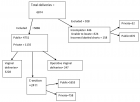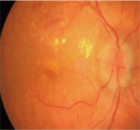Abstract
Short Review
Morular Metaplasia of the Endometrium: A Case Report and Literature Review: Care Pathways based on Molecular Biology
Dhanushka SK Kotigala and Tolu O Adedipe*
Published: 30 April, 2024 | Volume 7 - Issue 2 | Pages: 059-062
Background: Endometrial morular metaplasia, a clinical conundrum from a diagnostic and management angle given its rarity and low oncogenic potential, has been linked to endometrial hyperplasia and carcinoma.
Case report: A 77-year-old woman with no significant past medical history, was found to have an asymptomatic thickened endometrium on pelvic imaging, after presenting with lower abdominal pain, 3yrs ago. Diagnostic hysteroscopy identified an endometrial polyp within a pyometra. Histopathology showed focal complex endometrial hyperplasia without atypia with superimposed morular metaplasia(EMM) with a negative microbiology assay.
Following conservative management with multidisciplinary team(MDT) overview, as-per patient choice with 6-monthly follow-up hysteroscopy, endometrial biopsies and a short use of the Mirena® Intrauterine system (discontinued following poor tolerance), histopathology shows resolved hyperplasia with persistent EMM. Due to persistent disease, a hysterectomy is under consideration.
Discussion: Current evidence suggests that a sub-type of EMM, a likely histological manifestation of beta-catenin (CTNNB1) gene mutation: could be a precursor of endometrial hyperplasia and low-grade endometrioid-endometrial carcinoma sub-type. Though low-grade in nature, the increased recurrence risk raises significant concerns.
Prognostication following gene mutation identification can help with management options which include conservative, hormonal therapy with adjunct repeat endometrial sampling: or hysterectomy. The optimal frequency of endometrial sampling when uterine-sparing, is unclear, leading to a management conundrum, whilst persistent disease may require a hysterectomy.
Conclusion: Management of endometrial morular metaplasia can be difficult but must reflect the woman’s choice with a MDT-overview. Immuno-histochemical tools utilizing new molecular biological advances, can simplify the diagnostic and prognostication processes, aiding clinical management.
Read Full Article HTML DOI: 10.29328/journal.cjog.1001165 Cite this Article Read Full Article PDF
Keywords:
Endometrial metaplasia; Morular metaplasia; Atypical endometrial hyperplasia; Endometrioid carcinoma; Conservative treatment; Fertility
References
- Giroux V, Rustgi AK. Metaplasia: tissue injury adaptation and a precursor to the dysplasia-cancer sequence. Nat Rev Cancer. 2017 Oct;17(10):594-604. doi: 10.1038/nrc.2017.68. Epub 2017 Sep 1. PMID: 28860646; PMCID: PMC5998678.
- Goyette ERJ, Bentz JL. Endometrial metaplasia. PathologyOutlines.com website. https://www.pathologyoutlines.com/topic/uterusmetaplasia.html. Accessed March 15th, 2024.
- Travaglino A, Raffone A, Gencarelli A, Raimondo D, Moretta P, Pignatiello S, Granata M, Seracchioli R, Zullo F, Insabato L. Relationship between morular metaplasia and squamous differentiation in endometrial carcinoma. Pathol Res Pract. 2021 Jan;217:153307. doi: 10.1016/j.prp.2020.153307. Epub 2020 Nov 30. PMID: 33316539.
- Kujdowicz M, Milewicz T, Adamek D. Extensive squamous metaplasia (morulosis) of the endometrium as a clinical and pathological problem: a case report and literature study. Gynecol Endocrinol. 2020 May;36(5):460-464. doi: 10.1080/09513590.2019.1696304. Epub 2020 Feb 10. PMID: 32037914.
- Makishi S, Kinjo T, Sawada S, Chinen K, Hirayasu T, Hamada T, Saito K, Iwamasa T. Morules and morule-like features associated with carcinomas in various organs: report with immunohistochemical and molecular studies. J Clin Pathol. 2006 Jan;59(1):95-100. doi: 10.1136/jcp.2005.026237. PMID: 16394288; PMCID: PMC1860262.
- Nicolae A, Preda O, Nogales FF. Endometrial metaplasias and reactive changes: a spectrum of altered differentiation. J Clin Pathol. 2011 Feb;64(2):97-106. doi: 10.1136/jcp.2010.085555. Epub 2010 Dec 1. PMID: 21126963.
- Litta P, Codroma A, D'Agostino G, Breda E. Morular endometrial metaplasia: review of the literature and proposal of the management. Eur J Gynaecol Oncol. 2013;34(3):243-7. PMID: 23967555.
- Nakatani Y, Masudo K, Miyagi Y, Inayama Y, Kawano N, Tanaka Y, Kato K, Ito T, Kitamura H, Nagashima Y, Yamanaka S, Nakamura N, Sano J, Ogawa N, Ishiwa N, Notohara K, Resl M, Mark EJ. Aberrant nuclear localization and gene mutation of beta-catenin in low-grade adenocarcinoma of fetal lung type: up-regulation of the Wnt signaling pathway may be a common denominator for the development of tumors that form morules. Mod Pathol. 2002 Jun;15(6):617-24. doi: 10.1038/modpathol.3880575. PMID: 12065775.
- Travaglino A, Raffone A, Russo D, Guadagno E, Pignatiello S, Moretta P, Zullo F, Del Basso De Caro M, Insabato L, Mascolo M. Does endometrial morular metaplasia represent odontogenic differentiation? Virchows Arch. 2021 Sep;479(3):607-616. doi: 10.1007/s00428-021-03060-2. Epub 2021 Mar 5. PMID: 33666744; PMCID: PMC8448715.
- Chiarelli S, Buriticá C, Litta P, Ciani S, Guarch R, Nogales FF. An immunohistochemical study of morules in endometrioid lesions of the female genital tract: CD10 is a characteristic marker of morular metaplasia. Clin Cancer Res. 2006 Jul 15;12(14 Pt 1):4251-6. doi: 10.1158/1078-0432.CCR-06-0398. PMID: 16857799.
- Zhang Y, Wang X. Targeting the Wnt/β-catenin signaling pathway in cancer. J Hematol Oncol. 2020 Dec 4;13(1):165. doi: 10.1186/s13045-020-00990-3. PMID: 33276800; PMCID: PMC7716495.
- Saegusa M, Hashimura M, Yoshida T, Okayasu I. beta- Catenin mutations and aberrant nuclear expression during endometrial tumorigenesis. Br J Cancer. 2001 Jan;84(2):209-17. doi: 10.1054/bjoc.2000.1581. PMID: 11161379; PMCID: PMC2363713.
- Saegusa M, Okayasu I. Frequent nuclear beta-catenin accumulation and associated mutations in endometrioid-type endometrial and ovarian carcinomas with squamous differentiation. J Pathol. 2001 May;194(1):59-67. doi: 10.1002/path.856. PMID: 11329142.
- Kim S, Jeong S. Mutation Hotspots in the β-Catenin Gene: Lessons from the Human Cancer Genome Databases. Mol Cells. 2019 Jan 31;42(1):8-16. doi: 10.14348/molcells.2018.0436. Epub 2019 Jan 7. PMID: 30699286; PMCID: PMC6354055.
- Lin MC, Lomo L, Baak JP, Eng C, Ince TA, Crum CP, Mutter GL. Squamous morules are functionally inert elements of premalignant endometrial neoplasia. Mod Pathol. 2009 Feb;22(2):167-74. doi: 10.1038/modpathol.2008.146. Epub 2008 Sep 19. PMID: 19180120; PMCID: PMC2633489.
- Kurnit KC, Kim GN, Fellman BM, Urbauer DL, Mills GB, Zhang W, Broaddus RR. CTNNB1 (beta-catenin) mutation identifies low grade, early stage endometrial cancer patients at increased risk of recurrence. Mod Pathol. 2017 Jul;30(7):1032-1041. doi: 10.1038/modpathol.2017.15. Epub 2017 Mar 10. PMID: 28281553; PMCID: PMC5493522.
- Chiarelli S, Buriticá C, Litta P, Ciani S, Guarch R, Nogales FF. An immunohistochemical study of morules in endometrioid lesions of the female genital tract: CD10 is a characteristic marker of morular metaplasia. Clin Cancer Res. 2006 Jul 15;12(14 Pt 1):4251-6. doi: 10.1158/1078-0432.CCR-06-0398. PMID: 16857799.
- Houghton O, Connolly LE, McCluggage WG. Morules in endometrioid proliferations of the uterus and ovary consistently express the intestinal transcription factor CDX2. Histopathology. 2008 Aug;53(2):156-65. doi: 10.1111/j.1365-2559.2008.03083.x. PMID: 18752499.
- Patkar R, Mishra S. Extensive morular metaplasia in an endometrial polyp – A rare occurrence - creating a diagnostic dilemma. IP Arch Cytol Histopathology Res. 2023;8(2):126-129.
- Zhu S, He L, Zheng C, Hou Y. Bladder mulberry-like fibroepithelial polyp with calcification and squamous cell metaplasia mimicking bladder carcinoma: case report and literature review. J Int Med Res. 2020 Jan;48(1):300060519896911. doi: 10.1177/0300060519896911. PMID: 32008408; PMCID: PMC7113808.
Figures:
Similar Articles
-
Utilization of post abortal contraceptive use and associated factors among women who came for abortion service at Debre Berhan Hospital, Debre Berhan, Ethiopia March 2019: Institution based cross sectional studyAbebe Muche*,Bekalu Bewket,Eferem Ayalew,Endale Demeke. Utilization of post abortal contraceptive use and associated factors among women who came for abortion service at Debre Berhan Hospital, Debre Berhan, Ethiopia March 2019: Institution based cross sectional study. . 2019 doi: 10.29328/journal.cjog.1001020; 2: 025-033
-
Epidemiologic aspects and risk factors associated with infertility in women undergoing assisted reproductive technology (ART) in north of IranMarzieh Zamaniyan,Noushin Gordani*,Paniz Bagheri,Kaveh Jafari,Sepideh Peyvandi,Mojtaba Hajihoseini,Robabeh Taheripanah,Siavash Moradi,Salomeh Peyvandi,Arman Alborzi. Epidemiologic aspects and risk factors associated with infertility in women undergoing assisted reproductive technology (ART) in north of Iran. . 2021 doi: 10.29328/journal.cjog.1001079; 4: 015-018
-
Laparoscopic staging of borderline ovarian tumours – Technique and resultsKlimatsouda M,Donoudis C,Kontopoulos G,Daponte A*. Laparoscopic staging of borderline ovarian tumours – Technique and results. . 2021 doi: 10.29328/journal.cjog.1001081; 4: 020-024
-
Synergistic interactions of sperm impairing bacteria: Impact on pregnancy outcome in mouse modelIsheeta Jangra,Aditi Chauhan,Vijay Prabha*. Synergistic interactions of sperm impairing bacteria: Impact on pregnancy outcome in mouse model. . 2021 doi: 10.29328/journal.cjog.1001083; 4: 033-039
-
Prediction of neonatal and maternal index based on development and population indicators: a global ecological studySedigheh Abdollahpour,Hamid Heidarian Miri,Talat Khadivzadeh*. Prediction of neonatal and maternal index based on development and population indicators: a global ecological study. . 2021 doi: 10.29328/journal.cjog.1001096; 4: 101-105
-
A two-phase sonographic study among women with infertility who first had normal sonographic findingsKalu Ochie*,Abraham John C. A two-phase sonographic study among women with infertility who first had normal sonographic findings. . 2022 doi: 10.29328/journal.cjog.1001117; 5: 101-103
-
Cesarean scar pregnancy: A clinical case reportAziz Slaoui*,Aicha Bennani,Roughaya Tayeb,Najia Zeraidi,Amina Lakhdar,Aziz Baydada,Aicha Kharbach. Cesarean scar pregnancy: A clinical case report. . 2023 doi: 10.29328/journal.cjog.1001119; 6: 006-009
-
Decline in human sperm parameters: How to stop?Aboubakr Mohamed Elnashar*. Decline in human sperm parameters: How to stop?. . 2023 doi: 10.29328/journal.cjog.1001122; 6: 016-020
-
Morular Metaplasia of the Endometrium: A Case Report and Literature Review: Care Pathways based on Molecular BiologyDhanushka SK Kotigala, Tolu O Adedipe*. Morular Metaplasia of the Endometrium: A Case Report and Literature Review: Care Pathways based on Molecular Biology. . 2024 doi: 10.29328/journal.cjog.1001165; 7: 059-062
-
Disposable Diapers in Infancy and Their Potential Detrimental Impact on Male Fertility in AdulthoodEliezer Girsh*. Disposable Diapers in Infancy and Their Potential Detrimental Impact on Male Fertility in Adulthood. . 2024 doi: 10.29328/journal.cjog.1001170; 7: 084-092
Recently Viewed
-
Clinical and Histopathological Mismatch: A Case Report of Acral FibromyxomaMonica Mishra*,Kailas Mulsange,Gunvanti Rathod,Deepthi Konda. Clinical and Histopathological Mismatch: A Case Report of Acral Fibromyxoma. Arch Pathol Clin Res. 2025: doi: 10.29328/journal.apcr.1001045; 9: 005-007
-
Unconventional powder method is a useful technique to determine the latent fingerprint impressionsHarshita Niranjan,Shweta Rai,Kapil Raikwar,Chanchal Kamle,Rakesh Mia*. Unconventional powder method is a useful technique to determine the latent fingerprint impressions. J Forensic Sci Res. 2022: doi: 10.29328/journal.jfsr.1001035; 6: 045-048
-
Doppler Evaluation of Renal Vessels in Pediatric Patients with Relapse and Remission in Different Categories of Nephrotic SyndromeAmit Nandan Dhar Dwivedi*, Srishti Sharma, OP Mishra, Girish Singh. Doppler Evaluation of Renal Vessels in Pediatric Patients with Relapse and Remission in Different Categories of Nephrotic Syndrome. J Clini Nephrol. 2023: doi: 10.29328/journal.jcn.1001112; 7: 067-072
-
Atlantoaxial subluxation in the pediatric patient: Case series and literature reviewCatherine A Mazzola*,Catherine Christie,Isabel A Snee,Hamail Iqbal. Atlantoaxial subluxation in the pediatric patient: Case series and literature review. J Neurosci Neurol Disord. 2020: doi: 10.29328/journal.jnnd.1001037; 4: 069-074
-
Intelligent Design of Ecological Furniture in Risk Areas based on Artificial SimulationTorres del Salto Rommy Adelfa*, Bryan Alfonso Colorado Pástor*. Intelligent Design of Ecological Furniture in Risk Areas based on Artificial Simulation. Arch Surg Clin Res. 2024: doi: 10.29328/journal.ascr.1001083; 8: 062-068
Most Viewed
-
Evaluation of Biostimulants Based on Recovered Protein Hydrolysates from Animal By-products as Plant Growth EnhancersH Pérez-Aguilar*, M Lacruz-Asaro, F Arán-Ais. Evaluation of Biostimulants Based on Recovered Protein Hydrolysates from Animal By-products as Plant Growth Enhancers. J Plant Sci Phytopathol. 2023 doi: 10.29328/journal.jpsp.1001104; 7: 042-047
-
Sinonasal Myxoma Extending into the Orbit in a 4-Year Old: A Case PresentationJulian A Purrinos*, Ramzi Younis. Sinonasal Myxoma Extending into the Orbit in a 4-Year Old: A Case Presentation. Arch Case Rep. 2024 doi: 10.29328/journal.acr.1001099; 8: 075-077
-
Feasibility study of magnetic sensing for detecting single-neuron action potentialsDenis Tonini,Kai Wu,Renata Saha,Jian-Ping Wang*. Feasibility study of magnetic sensing for detecting single-neuron action potentials. Ann Biomed Sci Eng. 2022 doi: 10.29328/journal.abse.1001018; 6: 019-029
-
Pediatric Dysgerminoma: Unveiling a Rare Ovarian TumorFaten Limaiem*, Khalil Saffar, Ahmed Halouani. Pediatric Dysgerminoma: Unveiling a Rare Ovarian Tumor. Arch Case Rep. 2024 doi: 10.29328/journal.acr.1001087; 8: 010-013
-
Physical activity can change the physiological and psychological circumstances during COVID-19 pandemic: A narrative reviewKhashayar Maroufi*. Physical activity can change the physiological and psychological circumstances during COVID-19 pandemic: A narrative review. J Sports Med Ther. 2021 doi: 10.29328/journal.jsmt.1001051; 6: 001-007

HSPI: We're glad you're here. Please click "create a new Query" if you are a new visitor to our website and need further information from us.
If you are already a member of our network and need to keep track of any developments regarding a question you have already submitted, click "take me to my Query."

















































































































































